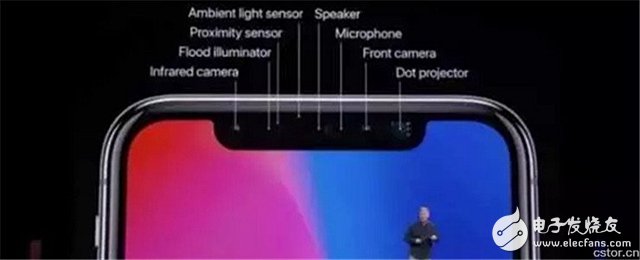**Is Face Recognition Really Safe? An iPhone X Perspective on Data Threats**
The rise of face recognition technology, especially with the launch of the iPhone X, has sparked a wave of enthusiasm. As we enjoy the convenience of facial unlocking, have we ever stopped to consider whether this technology is truly secure and whether our data is protected at the highest level?
What kind of data security concerns does the iPhone X's facial recognition raise?

At Apple’s recent conference, the iPhone X’s “bald bangs†captured everyone’s attention. Features like Face ID, dual-camera system, and augmented reality became the main selling points. The iPhone X was claimed to “define the future of smartphone design,†marking a new era in mobile technology and paying tribute to Steve Jobs, the late co-founder of Apple.

**How Does 3D Face Unlocking Work?**
Face ID is undoubtedly one of the standout features of the iPhone X. During the keynote, Apple highlighted nine key aspects of Face ID: face verification, depth sensing, simple registration, specialized neural networks, security, natural interaction, user privacy, attention-aware, adaptability, and integration with Apple Pay. Tim Cook emphasized the security of Face ID, stating that the chance of someone else unlocking your phone is only one in a million—far better than Touch ID.
This security comes from the hidden technology behind "the bangs": four of the eight components are involved in facial recognition (infrared camera, floodlight, ambient light sensor, and dot projector). With 30,000 sampling points, the front-end device captures and processes the face image, creating 3D facial data. Each unlock compares the latest data with previously stored information and sends it to the A11 chip’s Neural Engine for processing.
While Face ID has grabbed headlines and made the iPhone X a must-have, it has also raised serious concerns about personal privacy and data security. Netizens have expressed their worries through online comments:

Some netizens joked about anti-face recognition methods, revealing fears about the risks associated with facial data collection. Minnesota Democratic Senator Al Franken criticized Apple, suggesting that the company might be collecting facial data and potentially leaking it. He demanded Apple provide detailed information on how it protects biometric data.
A Stanford University study by Michal Kosinski and Yilun Wang demonstrated how deep learning models could detect sexual orientation from facial images, raising ethical concerns about the misuse of facial data. This research triggered public debate over the potential invasion of privacy and the need for stronger legal safeguards.
Our analysis using the Qingbo big data monitoring system found that 12.43% of netizens expressed negative emotions regarding iPhone X’s privacy risks, while 29.5% were neutral. Many remain skeptical about the security of facial recognition technology.
**Face Recognition Isn’t Just for iPhones**
Face recognition isn’t exclusive to the iPhone X. Before its release, Samsung’s Note 8 and Xiaomi’s Note 3 already used facial unlock. However, these systems relied on 2D imaging, making them vulnerable to photo-based attacks. This led to criticism and poor reviews.
Beyond smartphones, face recognition is being used in access control, surveillance, and payment systems. We’re entering an era where face scanning is becoming routine. From train stations to hotels, banks, and universities, facial recognition is rapidly expanding into daily life.
**Face Recognition and Privacy Risks**
Apple claims Face ID is 20 times more secure than Touch ID, thanks to infrared structured light and 3D depth sensing. The phone emits specific infrared light to capture 3D facial data, which resists flat-image attacks. Apple also states that it doesn’t store 3D facial data in the cloud, enhancing security.
Despite these measures, global data breaches continue to rise. In 2016 alone, there were over 900 data leaks, with financial theft and account compromise being the most common. In China, the Xu Yuyu case highlighted the dangers of telecom fraud, with annual cases growing by 20–30%. These incidents show that concerns about data security are not unfounded.
Moreover, smart ads based on user data have raised issues of discrimination and information exploitation. Companies analyze users’ behavior to deliver personalized ads, sometimes leading to targeted manipulation.
**Balancing Technology and Data Security**
Concerns about data privacy are not new. Germany introduced the right to data self-determination in 1983, and in 2014, the concept of the “right to be forgotten†was proposed. The EU’s General Data Protection Regulation (GDPR) now gives individuals more control over their data.
Judicially, companies like Google have faced legal challenges over data retention. In 2014, the European Court ruled that Google had to remove certain links upon request, setting a precedent for data deletion rights.
Technologically, researchers are developing countermeasures against face recognition. For instance, Grigory Bakunov created makeup techniques to fool facial recognition systems, while Japanese professor ISAO ECHIZEN developed glasses that block facial scans.
Data privacy is a double-edged sword. While it can lead to greater convenience and personalized services, it also raises ethical and security questions. Proper protection is key, but finding the right balance remains a challenge.
In conclusion, the development of facial recognition technology brings both opportunities and risks. Addressing these issues requires collaboration across disciplines—technology, law, policy, and ethics—to ensure that innovation serves society without compromising individual privacy.
Hp Laptop Series,Laptop Parts,Laptop Palmrest,Hp Palmrest
S-yuan Electronic Technology Limited , https://www.syuanelectronic.com